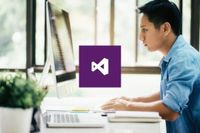This course will first cover the installation process of Visual Studio and help you select the correct options for your first Visual Basic program. You will study the different code terms, data types, variables, and statements that you can use, as well as the different syntax elements, operands, operators, strings, and iteration statements. You will also learn how to display the date and time in different formats for the end user to see.
Next, you will study the nature of classes, methods, scopes, and modifiers. The course will also cover Namespace, the .NET framework class library, and collections, as well as teach you the difference between generic and non-generic collections. You will also look into Language Integrated Query (LINQ) and enumerations including their functions in this programming language. Finally, you will study the 'Try Catch' and 'End Try' block code and learn when to use them while writing code.
Building software applications is a skill that one needs to develop constantly. This free online Diploma in Visual Basic Programming contains video tutorials that will ensure you clearly learn the different ways to write your code using Visual Basic. This is a great skills that will really boost your computer programming career. Check out the course today, and start learning how to build really engaging and useful applications in no time at all.
What You Will Learn In This Free Course
View All Learning Outcomes View Less All Alison courses are free to enrol, study, and complete. To successfully complete this Diploma course and become an Alison Graduate, you need to achieve 80% or higher in each course assessment.
Once you have completed this Diploma course, you have the option to acquire an official Diploma, which is a great way to share your achievement with the world.
Your Alison certificate is:
- Ideal for sharing with potential employers.
- Great for your CV, professional social media profiles, and job applications.
- An indication of your commitment to continuously learn, upskill, and achieve high results.
- An incentive for you to continue empowering yourself through lifelong learning.
Alison offers 2 types of Diploma for completed Diploma courses:
- Digital Diploma: a downloadable Diploma in PDF format immediately available to you when you complete your purchase.
- Physical Diploma: a physical version of your officially branded and security-marked Diploma
All Diplomas are available to purchase through the Alison Shop. For more information on purchasing Alison Diploma, please visit our FAQs. If you decide not to purchase your Alison Diploma, you can still demonstrate your achievement by sharing your Learner Record or Learner Achievement Verification, both of which are accessible from your Account Settings.











 Avg. Hours
Avg. Hours  Contains Video
Contains Video  CPD Accredited
CPD Accredited 
 Total XP:
Total XP: 
 Knowledge & Skills You Will Learn
Knowledge & Skills You Will Learn 






